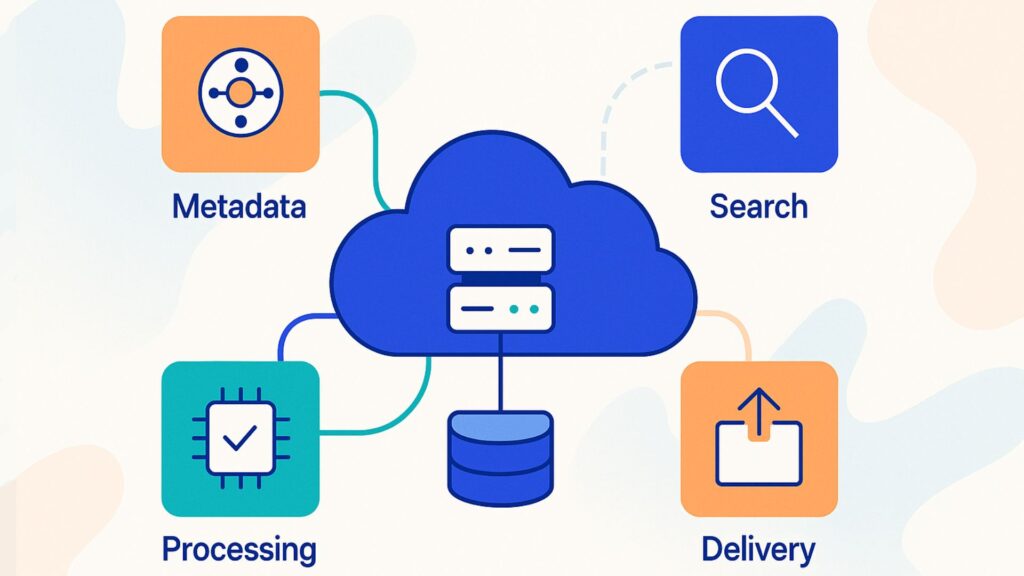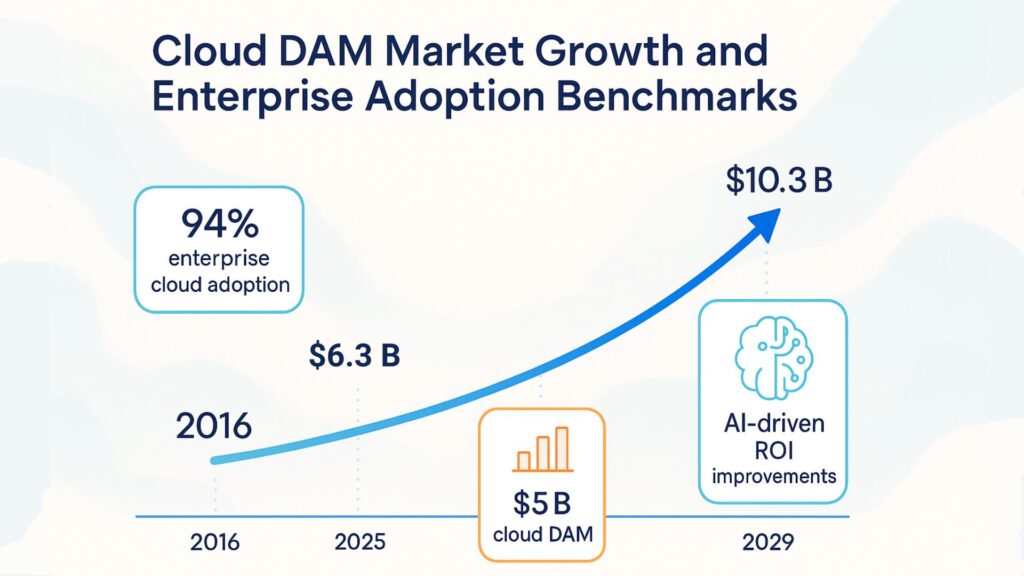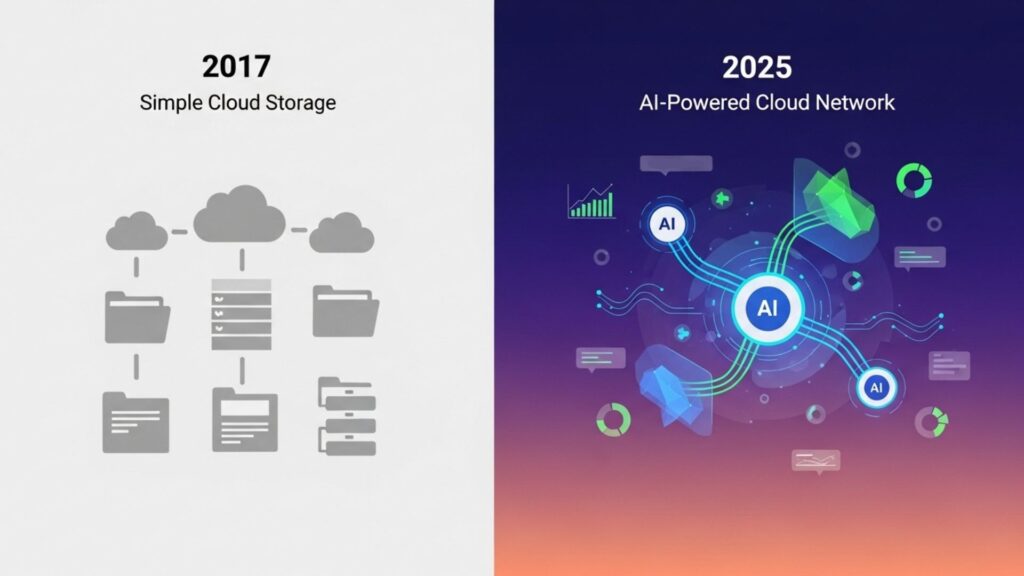Cloud digital asset management has transformed dramatically from basic storage solutions in 2017 to AI-powered, microservices-driven platforms in 2025.
- Market explosion: The global DAM market grew from $1.7B in 2016 to $6.3B in 2025, with cloud adoption reaching 94% of enterprises.
- AI revolution: Modern cloud DAM platforms now feature predictive metadata, automated tagging, and intelligent search capabilities that didn’t exist in 2017.
- Architecture evolution: Scalable microservices and hybrid cloud deployments replaced monolithic on-premise systems.
- Cost model shift: Organizations moved from large CAPEX investments to flexible OPEX subscription models, reducing upfront costs.
Cloud DAM has become the strategic backbone for intelligent content operations at enterprise scale.
Remember when “cloud DAM” meant little more than dumping files into online folders and hoping for the best? Those days feel like ancient history. The transformation of cloud digital asset management between 2017 and 2025 is one of the most dramatic technology evolutions in enterprise software.
Back in 2017, most organizations were still debating whether to trust the cloud with their precious brand assets. Fast-forward to 2025, and 78% of executives report their organizations have adopted cloud infrastructure across most business areas. The question is no longer “if” but “how fast” companies can leverage cloud DAM’s full potential.
What Made Cloud DAM Different in 2017?
In 2017, cloud digital asset management was essentially glorified file storage with some basic organizational features. The typical cloud DAM solution offered rudimentary folder structures, simple keyword search, and basic user permissions. Most platforms required extensive manual metadata entry, and AI capabilities were nonexistent.
Technology looked vastly different. Organizations were still heavily invested in on-premise infrastructure, viewing cloud solutions as experimental rather than strategic. Security concerns dominated boardroom discussions, with many executives questioning whether cloud providers could adequately protect sensitive brand assets.
Storage costs were higher, bandwidth limitations created bottlenecks for large file transfers, and integration capabilities were limited to basic APIs that required significant development resources. The concept of edge delivery was nascent, meaning global teams often struggled with slow asset access times.
How Has Cloud Digital Asset Management Evolved by 2025?
Modern cloud DAM platforms have evolved into sophisticated content intelligence systems that automate previously manual processes and deliver insights that drive business decisions.
Enhanced Metadata and Asset Intelligence
The most dramatic change involves how assets are tagged and organized. While 2017 platforms relied entirely on manual metadata entry, today’s solutions use computer vision and machine learning to automatically categorize content. Modern systems can identify objects, faces, text, emotions, and brand compliance issues within seconds of upload.
Advanced DAM platforms now generate predictive metadata that anticipates how assets will be used across different channels and campaigns. This intelligent categorization reduces manual tagging work while exponentially improving searchability.
AI-Powered Search and Discovery
The search capabilities available in 2025 would seem like magic to users from 2017. Natural language processing allows users to search using conversational queries like “images of people laughing with our logo visible” rather than relying on exact keyword matches.
Visual similarity search enables teams to find assets that match specific aesthetic criteria, even when they haven’t been explicitly tagged. Content recommendations suggest related assets based on usage patterns and campaign performance data, streamlining creative workflows.
AI in Cloud DAM: From Concept to Core Functionality
Artificial intelligence is a major differentiator between 2017 and 2025 cloud DAM solutions. What began as experimental features has become essential capabilities that define modern platforms.

Automated Content Analysis
Today’s AI-driven systems automatically analyze every aspect of uploaded content. They extract text from images and videos, identify key visual elements, assess brand compliance, and evaluate emotional tone. This comprehensive analysis happens in real time, creating rich metadata layers that enhance discoverability and governance.
Machine learning algorithms now predict asset performance based on historical data, helping content teams make data-driven decisions about which visuals will resonate with specific audiences. Some platforms can automatically generate multiple asset variations, adapting content for different channels and formats.
Intelligent Workflow Automation
AI has transformed approval workflows from linear processes into dynamic, context-aware systems. Modern platforms route content for review based on detected elements, automatically flagging potential brand, legal, or compliance issues. This intelligent routing reduces review cycles and accelerates time-to-market for campaigns.
Predictive analytics help teams anticipate content needs, identifying gaps in asset libraries before they impact campaign timelines. Brands can now shift from reactive content management to strategic content planning.
Scalable Microservices Architectures: Building for Growth
The architectural foundations of cloud DAM platforms have undergone a complete transformation since 2017. Monolithic systems that required massive upfront investments and lengthy implementation timelines have given way to modular, microservices-based architectures.

Modular Component Design
Modern scalable DAM platforms break core functionality into independent services that can be deployed, updated, and scaled separately. Microservices allow organizations to activate only the capabilities they need while maintaining the flexibility to expand functionality as requirements evolve.
Individual components handle specific functions, such as image processing, metadata management, search indexing, and delivery optimization. SaaS DAM solutions can scale particular services based on demand while maintaining overall system stability.
Cloud-Native Scalability
Unlike 2017 solutions that were essentially on-premise software hosted in data centers, today’s cloud DAM platforms are built specifically for cloud environments. They leverage auto-scaling capabilities, distributed processing, and global content delivery networks to efficiently handle massive workloads.
Modern platforms can support organizations with millions of assets and thousands of concurrent users without performance degradation. Integration capabilities have expanded dramatically, with platforms offering hundreds of pre-built connectors to marketing technology stacks.
Cost Models: The Dramatic Shift from CAPEX to OPEX
One of the most business-critical changes between 2017 and 2025 involves how organizations fund and account for DAM technology investments. This shift has altered the economics of digital asset management.

2017: Large Capital Investments
In 2017, implementing a robust DAM solution typically required significant capital expenditures. Organizations needed to purchase servers, storage infrastructure, software licenses, and networking equipment. These investments often exceeded six figures and required three- to five-year depreciation schedules.
IT teams needed specialized expertise to deploy and maintain these systems, adding ongoing personnel costs to the total cost of ownership. Scaling required additional hardware purchases and complex migration processes that could take months to complete.
2025: Flexible Operating Expenses
Modern SaaS DAM solutions operate on subscription-based models that convert large capital expenses into predictable operating expenses. Organizations pay monthly or annually based on usage metrics like storage volume, number of users, or API calls.
This shift offers financial advantages beyond cash flow improvements. Companies can deduct the full cost of subscription services immediately rather than depreciating assets over multiple years. The flexibility to scale services up or down based on actual needs eliminates waste from over-provisioned infrastructure.
Edge Delivery and Global Performance Optimization
The performance characteristics of cloud DAM solutions have improved through advanced content delivery technologies that barely existed in 2017.
Content Delivery Network Integration
Modern platforms leverage sophisticated CDN integration to deliver assets from edge locations closest to end users. This approach reduces latency from seconds to milliseconds, enabling real-time collaboration for global teams and seamless customer experiences.
Advanced platforms offer dynamic image and video optimization, automatically adjusting file formats, compression, and dimensions based on device capabilities and network conditions. This intelligent delivery ensures optimal performance regardless of access location or device type.
Hybrid Cloud Deployment Options
While 2017 organizations faced binary choices between on-premise and cloud deployment, 2025 platforms offer sophisticated hybrid architectures. Organizations can maintain sensitive assets on-premise while leveraging cloud capabilities for processing, delivery, and collaboration.
Hybrid deployments particularly benefit enterprises in regulated industries that require specific data residency while wanting to capitalize on cloud innovation and scalability benefits.
Integration Ecosystem: From Isolated Tools to Connected Platforms
Integration is another area of vast evolution between 2017 and 2025. Modern cloud DAM platforms function as central hubs within broader marketing technology ecosystems.
API-First Architecture
Contemporary platforms prioritize API-first design, enabling seamless integration with content management systems, marketing automation platforms, e-commerce solutions, and creative applications. This connectivity eliminates the data silos that plagued earlier implementations.
No-code integration tools allow business users to create connections without technical expertise, making it easier for teams to streamline workflows and automate processes across multiple systems.
Workflow Orchestration
Advanced platforms now orchestrate complex workflows that span multiple applications and teams. Assets can flow automatically from creation tools through approval processes to final deployment across various channels, with each step tracked and optimized based on performance data.
Security and Compliance: Enterprise-Grade Protection
Security capabilities have evolved from basic access controls in 2017 to comprehensive governance frameworks that address modern regulatory requirements and threat landscapes.
Current platforms offer granular permission controls, advanced encryption both in transit and at rest, comprehensive audit trails, and compliance frameworks for regulations like GDPR, CCPA, and industry-specific requirements. Digital rights management has become more sophisticated, automatically enforcing usage restrictions and expiration dates.
AI-powered content scanning identifies potential brand, legal, or compliance issues before assets enter workflows, reducing risk and accelerating approval processes.
Industry Benchmarks: Cloud DAM Market Growth
Cloud digital asset management has evolved from a niche solution to a core pillar of enterprise content operations. The global DAM market has surged from roughly $1.7 billion in 2016 to more than $6.3 billion by 2025, with the cloud DAM segment alone projected to reach $5 billion. This rapid growth mirrors a larger enterprise trend: 94% of organizations now use cloud services to power everything from content creation to compliance.
Looking ahead, the market shows no signs of slowing down. Analysts expect digital asset management to climb past $10 billion globally by 2029, driven by the growing demand for scalable, AI-powered systems that can support omnichannel content delivery and personalization. The shift reflects a redefinition of what DAM can do: it’s no longer just about managing files but about orchestrating intelligent content operations across the enterprise.

Organizations investing in modern cloud DAM solutions are realizing measurable ROI far beyond faster asset discovery. Automated metadata tagging, workflow optimization, and real-time content analytics are helping teams work smarter, reducing production bottlenecks, shortening approval cycles, and improving campaign performance across channels. The result is a more agile, data-driven approach to content that directly accelerates time-to-market and drives measurable business outcomes.
What Should Organizations Expect Next?
Looking ahead, several trends will continue shaping cloud digital asset management evolution:
Generative AI will enable automated content creation directly within DAM platforms, allowing teams to generate variations, translations, and format adaptations on demand. Advanced analytics will provide deeper insights into content performance and audience engagement patterns.
Edge computing will bring processing capabilities closer to content creators and consumers, further reducing latency and enabling more sophisticated real-time collaboration. Integration ecosystems will become even more sophisticated, with platforms serving as orchestration layers for entire content supply chains.
The shift toward composable architecture will allow organizations to assemble best-of-breed solutions while maintaining seamless user experiences. This approach provides maximum flexibility while avoiding vendor lock-in concerns.
Cloud DAM vs Traditional Solutions: The Clear Winner
The contrast between 2017 limitations and 2025 capabilities illustrates why cloud digital asset management has become the dominant deployment model. Modern platforms offer superior scalability, advanced AI capabilities, flexible cost structures, and robust integration ecosystems that traditional on-premise solutions can’t match.
Organizations continuing to rely on legacy DAM implementations face disadvantages as cloud-native competitors leverage advanced automation, intelligence, and agility. The evolution to intelligent content operations demonstrates how cloud DAM has become essential infrastructure for modern marketing and brand management.
Frequently Asked Questions
How do modern cloud DAM platforms deliver business value? Today’s cloud-based DAM solutions improve speed, control, and ROI by centralizing content operations in one system. Instead of acting as simple file storage, modern cloud DAM platforms connect workflows, analytics, and collaboration tools to streamline asset creation, governance, and delivery, driving measurable efficiency across marketing and creative teams.
What’s the biggest advantage of AI in cloud DAM systems? AI automates repetitive work and makes content more intelligent. It tags and categorizes assets instantly, predicts which visuals will perform best, and can automatically generate new, on-brand variations. Teams receive faster insight, higher productivity, and better content outcomes with less manual effort.
Why invest in a cloud DAM if we already have creative and marketing tools? A cloud DAM unifies everything you use. It integrates with existing tools like Adobe, CMS, and analytics platforms to create a single source of truth for all content. That means fewer silos, stronger compliance, and faster time-to-market, turning disconnected tools into one coordinated content ecosystem.
Experience the Future of Content Operations
The transformation of cloud digital asset management from 2017 to 2025 is one of the most operation-altering evolutions in enterprise software. Organizations that embrace these advanced capabilities position themselves for competitive advantage through intelligent content ops, operational efficiency, and strategic agility.
Aprimo’s AI-powered platform embodies this evolution. We’re built on scalable cloud architecture and infused with intelligent automation to help enterprises centralize assets, accelerate workflows, and power personalized experiences at scale. Discover how Aprimo’s DAM platform can transform your organization’s approach to digital asset management.


